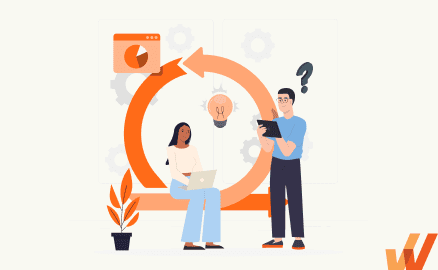
Priyanka Malik


Change management is foundational for organizational development and growth. Organizations that embrace and adapt to change succeed; however, many businesses shy away from transformational change projects in favor of the status quo due to these initiatives’ challenges and risks.
Change management models enable organizations to navigate through change and transitional phases by guiding team members toward adopting new digital applications, processes, workflows, and more – allowing businesses to maximize ROI from digital transformation initiatives.
One of the most influential theories for understanding organizational change is Kurt Lewin’s 3-step change model, which balances the driving and restraining forces to manage organizational change in three core phases: unfreezing, changing, and refreezing.
Kurt Lewin’s change model states that restraining forces influence the behavior of organizations and individuals, ultimately deciding the fate of change. The driving forces motivate and steer employees toward the new state. The restraining forces highlight potential resistance to change, acting as the prime barriers to change initiatives. Lewin’s three stages of change included:
Lewin suggests that it is crucial to balance these forces through effective change communication and employee involvement by providing training to bridge the skill gap. Change agents must implement stress management techniques, ensure compliance is met, and use convincing change reasoning.
To substantiate his Force Field Theory, Lewin suggested a straightforward three-step change model that aids employees’ ability to adapt to change: unfreezing, changing, and refreezing.

The first stage in Lewin’s model deals with perception management and aims to prepare the affected stakeholders for the upcoming organizational change. Change leaders must look at ways to improve the company’s preparedness for change and create a sense of urgency similar to Kotter’s change model.
During this stage, effective change communication plays a vital role in getting the desired team member buy-in and support of the people in the change management.
The following activities under the ‘unfreeze’ stage will help you embrace change better:
Once the status quo is disrupted, this stage deals with the implementation of change. In this stage, you must consider an agile and iterative approach that incorporates employee feedback to smoothen the transition.
You can further look at the following actionable items to keep uncertainty at bay:
Employees move away from the transition phase towards stabilization or acceptance in the final’ refreezing’ stage.
However, if change leaders fail to reinforce the change in org culture, employees might revert to previous behaviors.
The following activities will help you support the change.
Here are five significant ways that Lewin’s 3-stage change model can be applied to organizational change, including:
More often than not, every change initiative requires behavior modification and continuous upskilling of employees. Building on an existing skillset allows employees to take over more responsibilities. Therefore, offering ongoing employee training is crucial until the change is second nature.
Successful change initiative requires a balanced approach to changing the business processes, structures, and systems.
For example, McDonald’s incurred a multi-billion dollar loss due to its inability to balance innovation against process efficiencies. It failed to recognize how extensive customization to its food preparation would impact its speed and increase operational costs.
McKinsey suggests that companies with a strong culture achieve up to three times shareholder returns. To reap the long-term benefits of any change initiative, you must anchor the changes in org culture.
For example, Hubspot values culture and product equally. It has an extensive 128-page culture code check to ensure that its culture stays strong as ever. Additionally, Hubspot takes an employee-first approach and invests heavily in employee development and upskilling.
To ensure the successful adoption of new technology, organizations should create a sense of urgency, evaluate their current technology, prepare for the change, implement the new technology, and establish its long-term viability.
This approach can minimize failure risks, make the transition smoother, and enable organizations to reap the benefits of the new technology
When making changes to your product or service, it’s important to act quickly, evaluate the current offering, create a new plan, and integrate it into your company’s culture and processes. By following this change model, your organization can reduce the risk of failure, guarantee a successful implementation, and achieve your desired results.

Organizational change is rarely a straightforward process, and implementing Lewin’s change model can present several unique challenges. From resistance to change to breakdowns in communication, organizations must be prepared to navigate various obstacles to manage change effectively.
People are often hesitant to change their habits, routines, and ways of working, which can create resistance and pushback against the change initiative. This resistance can come in different forms like skepticism, fear, anxiety, or outright opposition.
If resistance to change is not addressed, it can ruin the change initiative and prevent it from being successful. As a result, it’s crucial to identify and understand the reasons for resistance and address them effectively. This may involve providing clear communication and education about the reasons for the change, involving employees in the change process, addressing concerns and fears, and providing support and resources to help employees adapt to the change.
Successful change initiatives require strong leadership and guidance. When leaders actively support and promote change, employees are much more likely to prioritize it and understand its importance. Leadership is crucial in setting the tone for change by providing direction, resources, and alignment with the organization’s vision and goals. Without strong leadership, employees may feel uncertain and unsupported, leading to resistance and disengagement.
To prevent this, leaders must communicate the vision, provide guidance and resources, and involve employees in the change process. By demonstrating their support for the change initiative, leaders can build momentum, create buy-in, and increase the likelihood of successful implementation.
To make change initiatives successful, organizations need to allocate sufficient time, money, and other resources. When resources are lacking, implementation can be compromised and quality can suffer. Employees may also resist changes if they feel unsupported or overworked, making it difficult to maintain momentum.
Organizations should identify and allocate the necessary resources appropriately, whether that means securing more funding or staffing, re-prioritizing existing resources, or finding creative solutions to resource constraints. This will increase the likelihood of successful implementation and help achieve the desired outcomes of the change initiative.
It’s essential to communicate clearly and consistently for change initiatives to run smoothly. Poor communication can lead to confusion, skepticism, or resistance among employees, making it hard to build engagement and sustain the change over time.
To avoid this, develop a clear communication plan that outlines the key messages, channels, and timing for communication throughout the change process. The plan should be tailored to the needs and preferences of different stakeholders and delivered in a timely and consistent manner.
In order to successfully implement change initiatives, it is crucial that employees receive proper employee training and end-user support. Failing to do so can result in frustration, mistakes, and resistance among employees, which can ultimately hinder the success of the change effort.
To prevent this, invest in creating effective training materials, conducting workshops, providing coaching, and offering ongoing feedback and support. Organizations can greatly increase their chances of achieving the desired outcomes by taking these steps to ensure that employees possess the knowledge and skills necessary to support the change initiative.
✓ Thank you, the checklist will be sent to your email
To understand Lewin’s change theory, let’s explore three examples of successful organizational change that applied Lewin’s three-step model.
Nissan Motor Company was on the verge of bankruptcy due to its financial debt and constantly declining market share.
To overcome this, Nissan entered a strategic alliance with Renault. Powered by change agent Carlos Ghosn, Nissan built a plan to shed its financial debt and expand Renault’s market share.
Carlos Ghosn faced the challenge of implementing a transformational change and turning around Nissan’s operations to make them profitable.
In 2017, McDonald’s implemented Lewin’s change model to overhaul its business strategy and operations. At the time, McDonald’s was struggling to keep up with changing consumer preferences and was losing market share to competitors.
McDonald’s recognized the need for change and began by unfreezing its current business model. The company’s leadership team communicated the need for change to the employees, explaining why the traditional fast-food model was no longer effective and how the new changes would benefit the company and its customers.
McDonald’s then began implementing changes to its business model and operations, such as introducing all-day breakfast, creating more customizable options for its menu, and revamping its in-store technology to improve efficiency and customer experience. These changes were based on customer research and feedback and aimed at meeting customers’ evolving needs.
During this stage, McDonald’s faced some resistance from franchisees and employees who were accustomed to the old ways of doing things. However, the company’s leadership team continued to communicate the benefits of the changes and worked with franchisees and employees to ensure they had the necessary resources and training to adapt to the new model.
McDonald’s fully implemented the changes and were then able to evaluate their success. The necessary adjustments were made, and the new business model was solidified by incorporating it into the company’s policies and culture. Employees who adapted to the changes were recognized and rewarded, and the company constantly continues to monitor and assess the effectiveness of its business model and operations to this day.
In the mid-2000s, Nokia held a dominant position in the global mobile phone market with its feature phones. The company eventually realized that the market was shifting towards smartphones, and to remain competitive, it needed to adjust its business model and technology.
Nokia started by unfreezing its current business model and technology and communicating the need for change to its employees. The company explained the ineffectiveness of the traditional feature phone model and how the new changes would benefit the company and its customers.
Nokia then introduced its own smartphone platform, Symbian, and collaborated with Microsoft to develop the Windows Phone platform. The company also prioritized enhancing the user experience with features like touchscreens and higher-quality cameras.
Despite some resistance from employees accustomed to the traditional feature phone model, Nokia’s leadership team continued to convey the benefits of the changes and provided employees with the necessary resources and training to adapt to the new technology.
After fully implementing the changes, Nokia conducted a thorough assessment of its success and made the necessary adjustments. The new business model and technology were seamlessly integrated into the company’s policies and culture, and Nokia prioritized acknowledging and rewarding its employees for their efforts in adapting to the changes.

It’s clear that Lewin’s change model framework has stood the test of time and remains a valuable tool for organizations looking to navigate change. From the unfreezing stage to the refreezing stage, Lewin’s change model provides a comprehensive roadmap for managing the complex process of organizational change.
But the truth is, navigating change is never easy. That’s why it’s important to have the right resources and tools at your disposal. And when it comes to change management, Whatfix is a game-changer. With its intuitive platform and powerful capabilities, Whatfix empowers teams to manage change more effectively and efficiently than ever before.
If you’re looking to implement Lewin’s change model or any other change management framework, consider leveraging the power of Whatfix. With Whatfix, you can take control of change and ensure a smooth transition every time.
Try Whatfix today and see the difference for yourself.

Thank you for subscribing!
Thank you for subscribing!